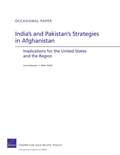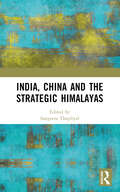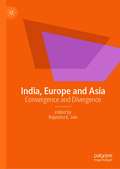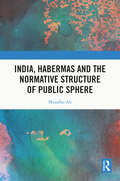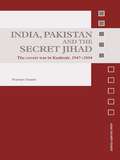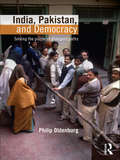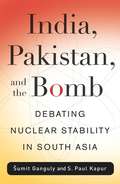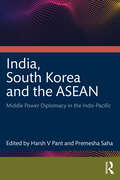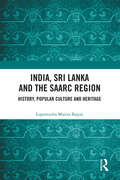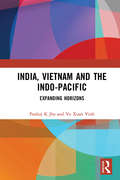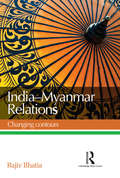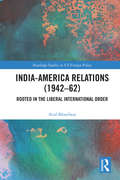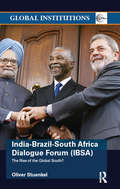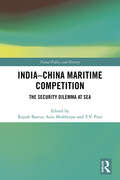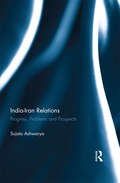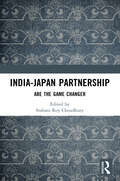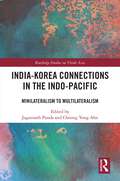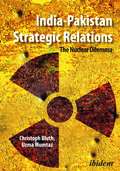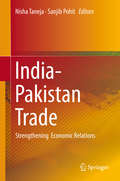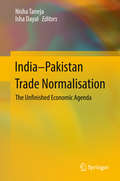- Table View
- List View
India's and Pakistan's Strategies in Afghanistan: Implications for the United States and the Region
by Peter Chalk Larry HanauerIndia and Pakistan have very different visions for Afghanistan, and they seek to advance highly disparate interests through their respective engagements in the country. This paper reviews the countries' interests in Afghanistan, how they have tried to further their interests, how Afghanistan navigates their rivalry, and the rivalry's implications for U. S. and Indian policy.
India, China and the Strategic Himalayas
by Sangeeta ThapliyalThis book analyses strategic discourse on the Himalayas from the perspective of India’s interests. Home to many communities, cultures, natural resources and political boundaries, it is the geopolitical landscape of the Himalayas between India and China that dominates other narratives and discourses. The traditional notion of Himalayas as India’s frontiers and buffer is challenged by China. Despite various mechanisms to address border resolution there are violations and transgressions from China. This book examines India’s responses to the new emerging challenges in the Himalayas. How the statist discourse on strategic interests incorporates people’s discourse. It provides a nuanced understanding of India’s strategic undertakings, diplomatic initiatives and development framework. This book will be a valuable addition to existing knowledge on the Himalayas between India and China. Scholars and practitioners interested in International Relations, Strategic Studies, Himalayan Studies and South Asian Studies will find it useful. Print edition not for sale in South Asia (India, Sri Lanka, Nepal, Bangladesh, Pakistan and Bhutan)
India, Europe and Asia: Convergence and Divergence
by Rajendra K. JainThis book examines the economic, political and security interests of India, Europe and the European Union towards Asia. It analyses their participation in major Asian multilateral organizations, responses to connectivity and Brussels’ differential engagement of China and India. It evaluates Indian and European/EU policy towards West Asia, the Iran Imbroglio, the Indo-Pacific and South Asia (Afghanistan, Myanmar and Kashmir). It highlights the elements of convergence/divergence and assesses the challenges and prospects of India-European cooperation in the context of a more assertive China and growing European engagement with Asia.
India, Habermas and the Normative Structure of Public Sphere
by Muzaffar AliThis book examines how the contemporary Indian situation poses a strict theoretical challenge to Habermas’s theorization of the public sphere and employs the method of samvāda to critically analyse and dissect its universalist claims. It invites the reader to consider the possibility of imagining a normative Indian public sphere that is embedded in the Indian context—in a native and not nativist sense—to get past the derivative language of philosophical and political discourses prevalent within Indian academia. The book proposes that the dynamic cooperative space between Indian political theory and contemporary Indian philosophy is effectively suited to theorize the native idea of the Indian public sphere. It underlines the normative need for a natively theorized Indian public sphere to further the multilayered democratization of public spheres within diverse communities that constitute Indian society. The book will be a key read for contemporary studies in philosophy, political theory, sociology, postcolonial theory, history and media and communication studies.
India, Japan and Beyond: Human Security, Environment, Development, Innovation and Resilience
by Rajib Shaw Srabani Roy ChoudhuryJapan–India relations have traversed from "distantly friendly" to "indispensable partners." The significant development of the India-Japan strategic partnership, the convergence of bilateral strategies, and the addressing of broader economic relations and cultural dimensions signify that bilateral relations have entered a "new era" in Japan-India relations. Given the region's emerging geopolitics, diplomatic relations between these two nations have gained momentum beyond the traditional pillars of engagement. New dimensions, namely, human security, environment, disaster risk reduction, climate change issues, innovation, and resilience building have gained currency. Addressing these, this book covers the broader aspects of human security dimensions of India-Japan collaboration. Involving multi and trans-disciplinary research, including in-depth reviews and new data based on case studies from India and Japan, this book sheds light on new convergence frontiers between these two nations. Furthermore, the book suggests specific policy and action measures to enhance human security through the bilateral cooperation between India and Japan, which has a global impact.
India, Pakistan and the Secret Jihad: The Covert War in Kashmir, 1947-2004 (Asian Security Studies)
by Praveen SwamiIndia, Pakistan and the Secret Jihad explores the history of jihadist violence in Kashmir, and argues that the violent conflict which exploded after 1990 was not a historical discontinuity, but, rather, an escalation of what was by then a five-decade old secret war. Praveen Swami addresses three key issues: the history of jihadist violence in Jammu and Kashmir, which is examined as it evolved from 1947-48 onwards the impact of the secret jihad on Indian policy-making on Jammu and Kashmir, and its influence on political life within the state why the jihad in Jammu and Kashmir acquired such intensity in 1990. This new work will be of much interest to students of the India-Pakistan conflict, South Asian politics and security studies in general.
India, Pakistan, and Democracy: Solving the Puzzle of Divergent Paths
by Philip OldenburgThe question of why some countries have democratic regimes and others do not is a significant issue in comparative politics. This book looks at India and Pakistan, two countries with clearly contrasting political regime histories, and presents an argument on why India is a democracy and Pakistan is not. Focusing on the specificities and the nuances of each state system, the author examines in detail the balance of authority and power between popular or elected politicians and the state apparatus through substantial historical analysis. India and Pakistan are both large, multi-religious and multi-lingual countries sharing a geographic and historical space that in 1947, when they became independent from British rule, gave them a virtually indistinguishable level of both extreme poverty and inequality. All of those factors militate against democracy, according to most theories, and in Pakistan democracy did indeed fail very quickly after Independence. It has only been restored as a façade for military-bureaucratic rule for brief periods since then. In comparison, after almost thirty years of democracy, India had a brush with authoritarian rule, in the 1975-76 Emergency, and some analysts were perversely reassured that the India exception had been erased. But instead, after a momentous election in 1977, democracy has become stronger over the last thirty years. Providing a comparative analysis of the political systems of India and Pakistan as well as a historical overview of the two countries, this textbook constitutes essential reading for students of South Asian History and Politics. It is a useful and balanced introduction to the politics of India and Pakistan.
India, Pakistan, and the Bomb: Debating Nuclear Stability in South Asia
by Ganguly Umit S. Paul KapurIn May 1998, India and Pakistan put to rest years of speculation as to whether they possessed nuclear technology and openly tested their weapons. Some believed nuclearization would stabilize South Asia; others prophesized disaster. Authors of two of the most comprehensive books on South Asia's new nuclear era, Sumit Ganguly and S. Paul Kapur, offer competing theories on the transformation of the region and what these patterns mean for the world's next proliferators. Ganguly begins with an outcome-based approach emphasizing the results of militarized conflict. In his opinion, nuclear weapons have prevented Indo-Pakistani disputes from blossoming into full-scale war. Kapur counters with a process-based approach stressing the specific pathways that lead to conflict and escalation. From his perspective, nuclear weapons have fueled a violent cycle of Pakistani provocation and Indian response, giving rise to a number of crises that might easily have spun into chaos. Kapur thus believes nuclear weapons have been a destabilizing force in South Asia and could similarly affect other parts of the world. With these two major interpretations, Ganguly and Kapur tackle all sides of an urgent issue that has profound regional and global consequences. Sure to spark discussion and debate, India, Pakistan, and the Bomb thoroughly maps the potential impact of nuclear proliferation.
India, Pakistan, and the Bomb: Debating Nuclear Stability in South Asia (Contemporary Asia in the World)
by S. Paul KapurIn May 1998, India and Pakistan put to rest years of speculation as to whether they possessed nuclear technology and openly tested their weapons. Some believed nuclearization would stabilize South Asia; others prophesized disaster. Authors of two of the most comprehensive books on South Asia's new nuclear era, Šumit Ganguly and S. Paul Kapur, offer competing theories on the transformation of the region and what these patterns mean for the world's next proliferators. Ganguly begins with an outcome-based approach emphasizing the results of militarized conflict. In his opinion, nuclear weapons have prevented Indo-Pakistani disputes from blossoming into full-scale war. Kapur counters with a process-based approach stressing the specific pathways that lead to conflict and escalation. From his perspective, nuclear weapons have fueled a violent cycle of Pakistani provocation and Indian response, giving rise to a number of crises that might easily have spun into chaos. Kapur thus believes nuclear weapons have been a destabilizing force in South Asia and could similarly affect other parts of the world. With these two major interpretations, Ganguly and Kapur tackle all sides of an urgent issue that has profound regional and global consequences. Sure to spark discussion and debate, India, Pakistan, and the Bomb thoroughly maps the potential impact of nuclear proliferation.
India, South Korea and the ASEAN: Middle Power Diplomacy in the Indo-Pacific
by Harsh V PantWith the US-China geostrategic competition heating up, it is an opportune time for South Korea, ASEAN and India to draw on their middle power status to bolster regional security and economic cooperation to protect their interests from any potential superpower fallout. This book investigates the diverse possibilities for collaboration within the India-ASEAN-ROK trilateral framework. It explores the various avenues of cooperation that this new trilateral initiative can benefit from, ranging from security, economic, institutional platforms and technology to sustainable development and climate change. The book provides regional perspectives on India, ASEAN and ROK to show the growing appetite in these countries for such trilateral initiatives and to forecast the challenges that may arise.Lucid and topical, this book will be an essential read for scholars and researchers of political science, international relations, diplomacy and strategic studies, as well as Southeast Asian, East Asian and South Asian studies. It will also be of use to thinktanks and policymakers interested in Indo-Pacific, India-ASEAN and India-ROK issues.
India, Sri Lanka and the SAARC Region: History, Popular Culture and Heritage
by Lopamudra Maitra BajpaiThis book examines the historical and socio-cultural connections across the SAARC region, with a special focus on the relationship between India and Sri Lanka. It investigates hitherto unexplored narratives of history, popular culture and intangible heritage in the region to identify the cultural parallels and intersections that link them together. In doing so, the volume moves away from an organised and authorised heritage discourse and encourages possibilities of new understandings and re-interpretations of cross-cultural communication and its sub-texts. Based on original ethnographic work, the book discusses themes such as cultural ties between India and Sri Lanka, exchanges between Arthur C. Clarke in Sri Lanka and Satyajit Ray in India, cultural connectivity reflected through mythology and folklore, the influence of Rabindranath Tagore on modern dance in Sri Lanka, the introduction of railways in Sri Lanka, narrative scrolls and masked dance forms across SAARC countries, Hindi cinema as the pioneer of cultural connectivity, and women’s writing across South Asia. Lucid and compelling, this book will be useful for scholars and researchers of cultural studies, South Asian studies, cultural anthropology, sociology, popular culture, cross-cultural communication, gender studies, political sociology, cultural history, diplomacy, international relations and heritage studies. It will also appeal to general readers interested in the linkages between India and Sri Lanka.
India, Vietnam and the Indo-Pacific: Expanding Horizons
by Pankaj K Jha Vo Xuan VinhThis book delves into the examination of bilateral relations between India and Vietnam in the 21st century and how the Indo-Pacific as a geo-political construct lends itself to the improvement of their engagement. With the rise and increasing assertiveness of China, the slow growth of the United States, the resurgence of Japan, and the oscillating role of ASEAN as a multilateral organization, the Indo-Pacific has emerged as a theatre of international geostrategic competition. This book studies these changing geopolitical realities and new evolving strategic configurations, while addressing political, economic, defence, and strategic aspects of the relationship along with the role of China and the US in facilitating ties. India’s Act East Policy that was upgraded from the Look East Policy – one of the main drivers for India’s increasing presence in the Asia-Pacific region – is also examined in this volume. An important intervention in the study of international relations, this book will be indispensable to students and researchers of maritime studies, security studies, politics and international relations, geopolitics, and Asian studies.
India--Myanmar Relations: Changing contours
by Rajiv BhatiaThis book provides a comprehensive evaluation of India's multi-faceted relations with Myanmar. It unravels the mysteries of the complex polity of Myanmar as it undergoes transition through democracy after long military rule. Based on meticulous research and understanding, the volume traces the trajectory of India–Myanmar associations from ancient times to the present day, and offers a fascinating story in the backdrop of the region’s geopolitics. An in-depth analysis of ‘India–Myanmar–China Triangle’ brings out the strategic stakes involved. It will be of great interest to researchers and scholars of international relations, peace and conflict studies, defence and strategic studies, politics, South and Southeast Asian studies, as well as policy-makers and political think tanks.
India-America Relations: Rooted in the Liberal International Order (Routledge Studies in US Foreign Policy)
by Atul BhardwajExamining India-America relations between 1942-62, this book reconsiders the role of America in shaping the imagination of post-colonial India. It rejects a conventional orthodoxy that assigns a limited role to America and challenges narratives which neglect the natural asymmetries and focus on discord and differences to define India-America relations. Integrating the security, political and economic elements of the Indo-American relationship it presents a synthesis of India’s encounter with the post-war hegemon and looks at the military, economic and political involvement of America during the ‘transfer of power’ from Britain to India. Bhardwaj delves into the role of American non-government agencies and examines the anti-communist ideological linkages that the Indian political class developed with America, the influence of this bonding and the role of American ideas, experts, funds, international relations and strategy in shaping India’s social, economic and educational institutions. Analyzing India’s non-alignment policy and its linkages to American policy on the non-communist neutrals, it argues that India’s movement towards the Soviet Union and away from China in the mid 1950s was in tune with the American strategy to cause the Sino-Soviet split. The book presents a fresh perspective based on authentic records and adds a new dimension to the understanding of modern Indian history and Indo-American relations. It will appeal to scholars and students of Indian and American history, international relations and strategy.
India-Brazil-South Africa Dialogue Forum: The Rise of the Global South (Global Institutions)
by Oliver StuenkelThe establishment of the IBSA as one of the principal platforms of South-South cooperation is one of the most notable developments in international politics during the first decade of the twenty-first century. While the concept is now frequently referred to in discussions about the Global South, there has not yet been a comprehensive and scholarly analysis of the history of the IBSA grouping and its impact on global order. This book: Offers a definitive reference history of the IBSA grouping (India, Brazil and South Africa) – a comprehensive, fact-focused narrative and analytical account from its inception as an ad hoc meeting in 2003 to the political grouping it is today. Situates the IBSA grouping in the wider context of South-South cooperation and the global shift of power away from the United States and Europe towards powers such as Brazil, India and South Africa. Provides an outlook and critically assesses what the IBSA grouping means for global order in the twenty-first century. Offering the first full-length and detailed treatment of the IBSA, this work will be of great interest to students and scholars of International organizations, international relations and the global south.
India-China Dialogues Beyond Borders: Cultural, Social Economic and Political Perspectives
by Ranjana Sheel Swati MishraThis book is a collection of contributions related to India–China relationship beyond the issue of borders. It focuses on those elements that play important role in defining, continuing, and strengthening the interaction between the two countries. In doing so, it explores roles of language and linguistics, history and culture, politics and economy, and philosophy and sociology that mediated ancient and modern interfaces. The book observes the role of silk route in the economic, political, and scholarly exchanges between ancient civilizations and in the movement of Buddhism to China and other Asian nations. The contributors highlight how the two countries have co-existed in various eras and tackled issues of conflict and cooperation during lows and highs in the past and present. It pays special attention to the role of language and linguistic competence as an important component of socio-cultural comprehension of a society and introduces major innovations and challenges in teaching and learning the Chinese language. The wide-ranging contributions make the book an attractive resource for academics, think-tanks, diplomats, and researchers working on Asian/India–China studies across the globe.
India-China Maritime Competition: The Security Dilemma at Sea (Cass Series: Naval Policy and History)
by T. V. Paul Rajesh Basrur Anit MukherjeeThis edited volume critically examines the concept of the “security dilemma” and applies it to India–China maritime competition. Though frequently employed in academic discussion and popular commentary on the Sino-Indian relationship, the term has rarely been critically analysed. The volume addresses the gap by examining whether the security dilemma is a useful concept in explaining the naval and foreign policy strategies of India and China. China’s Belt and Road Initiative and its expansive engagement in the Indian Ocean Region have resulted in India significantly scaling up investment in its navy, adding ships, naval aircraft and submarines. This volume investigates how the rivalry is playing out in different sub-regions of the Indian Ocean, and the responses of other powers, notably the United States and prominent Southeast Asian states. Their reactions to the Sino-Indian rivalry are an underexplored topic and the chapters in this book reveal how they selectively use that rivalry while trying to steer clear of making definite choices. The book concludes with recommendations on mitigating the security dilemma. This work will be of great interest to students of strategic studies, international relations, maritime security, and Asian politics.
India-Iran Relations: Progress, Problems and Prospects
by Sujata AshwaryaThis book examines India’s relationship with Iran since the post-World War II period and its unique search for meaningful bilateral ties in the West Asian region in the context of the changing regional and international scenarios. The four chapters highlight the achievements and constraints on the development of Indo-Iranian relations during the Cold War era; opportunities and limitations in bilateral engagements between India and Iran in the aftermath of the Cold War; impact of the ‘US factor’ on the development of crucial Indo-Iranian energy ties and the limitation imposed by India’s relations with Israel and Saudi Arabia on the India–Iran ties. More specifically, the four chapters touch on the central drivers—energy imports, access to Central Asia, cooperation in Afghanistan, mutual trade and economic investments and security ties—of India’s Iran policy, and how they structure India’s interaction with the other countries of the region and impact on the articulation of national interests. Combining a rich interplay of facts and figures with nuanced analyses, this volume will be a valuable resource for scholars, policymakers, diplomats and any interested reader desirous of knowing more about Indo-Iranian relations in particular and India’s West Asia policy in general. Please note: Taylor & Francis does not sell or distribute the Hardback in India, Pakistan, Nepal, Bhutan, Bangladesh and Sri Lanka
India-Japan Partnership: Abe the Game Changer
by Srabani Roy ChoudhuryThis book discusses the influence and impact of Shinzo Abe, Japan’s youngest and longest-serving Prime Minister in the post-Second World War, on international relations between India and Japan. The subject matter concentrates on Abe’s 2006-2007 and 2012-2020 regimes. Building on civilisation linkages, shared values, and mutual interest, Abe pegged the relationship with India as a strategic requirement for his vision for the Indo-Pacific region. Drawing linkages between Abe’s vision for Japan and India’s ambition at the world theatre, the contributing authors explore the various dimensions of this partnership. Critically appraising this bilateral relation, drawing on the convergence of India-Japan interest in the multilateral form, Abe’s impact on the media, and his display of soft power diplomacy, this book analyses the diverse spheres that have spun this partnership to a new orbit.Print edition not for sale in South Asia (India, Sri Lanka, Nepal, Bangladesh, Pakistan and Bhutan)
India-Korea Connections in the Indo-Pacific: Minilateralism to Multilateralism (Routledge Studies on Think Asia)
by Choong Yong Ahn Jagannath PandaIndia‑Korea Connections in the Indo‑Pacific presents multidimensional aspects of the Special Strategic Relationship between the Republic of Korea (ROK) and India, ranging from security, diplomacy, trade and FDI, and people‑to‑people exchanges. It analyses the India‑Korea partnership and its strategic implications and potential in the Indo‑Pacific.Bringing together experts from both India and the ROK, this book situates the partnership in the context of the current geopolitical landscape in the Indo‑Pacific, particularly the increasingly intensifying US‑China rivalry and the post‑pandemic and geo‑economic fragmentation caused by the Russian invasion of Ukraine. In this context, the chapters explore how the ROK and India as middle powers can strengthen the bilateral relationship between India and ROK and then work together within a host of existing minilateral and multilateral architectures in the Indo‑Pacific for a rule‑based international order embracing security and diplomacy, supply chain resilience, and cross‑border FDI and trade cooperation as evident in Quad, IPEF, RCEP, CPTPP, DEPA. This book is a unique collaboration between experts across various domains from both countries, and it presents a new take on the India‑ROK bilateral relationship as a middle power axis in the Indo‑Pacific.Presenting action‑oriented policy recommendations for ROK and India to pursue an upgradation of the existing ROK‑India Special Strategic Partnership, this book will be of interest to researchers in the fields of Asian/Indo‑Pacific studies, international relations and political science, looking to understand the India‑Korea partnership and its strategic implications and potential in the Indo‑Pacific, and policy analysts and professionals working in think tanks and research institutions, focused on foreign and security dynamics in the Indo‑Pacific.
India-Pakistan
by Ashutosh MisraThis book is an attempt to dig out the positive aspects of past Indo-Pakistani engagements and explore the relevant lessons to help resolve the current issues and disputes.
India-Pakistan Strategic Relations: The Nuclear Dilemma
by Christoph Bluth Uzma MumtazIndia and Pakistan have been in a state of persistent conflict that goes back to the very creation of these states after decolonization. This conflict has resulted in several wars and continuing armed clashes. After both states became nuclear powers, one would have expected a fundamental change in the way they wage war, since it is a fundamental principle of International Relations theory that nuclear-armed states do not go to war with each other. But the situation in South Asia seems to defy this principle. India’s conventional superiority should be neutralized by Pakistan’s nuclear capability, while Pakistan’s risk-taking behavior should be reduced. But as a matter of fact, the situation has turned out quite differently: Although large-scale conventional wars have not occurred, the nuclear status seems to have encouraged conflict and risk-taking. The number of armed clashes rose. Bluth and Mumtaz scrutinize the atypical and seemingly paradoxical impact of nuclearization on the conflict between India and Pakistan, paying extra attention on the question of how stable this paradoxical strategic relation-ship is. They demonstrate that the dominant paradigm used in the International Relations literature is by far not adequate to explain the strategic relations between India and Pakistan and set to work on developing a more coherent explanation. A must-read for everyone interested in International Relations and conflict resolution research.
India-Pakistan Trade
by Sanjib Pohit Nisha TanejaExamining the implications of recent important developments, the primary aim of this book is to bridge the gaps in existing literature on India-Pakistan economic engagement and to examine various aspects of the trade normalization process. The book includes familiar themes of India-Pakistan bilateral trade in goods and services, providing new insights into the potential for trade and the challenges involved in realizing it. The respective chapters examine the current trade trends and identify the possible sectors for bilateral FDI flows between the two countries, which could help forge deeper economic ties between them. In light of India's changed investment policy, this analysis is pertinent for investors and policy-makers alike. The book also includes chapters on a variety of unconventional subjects, such as estimating the levels of informal trade, an analysis of a trade perception survey and identifying trade potential using a CGE modeling approach. Further, a number of sectors have been identified for in-depth analysis, including sports goods, healthcare and energy. These sector-based analyses reflect the gap between current levels of trade in the selected industries and the possible trade potential. The studies identify key tradable commodities in the health and sports industries, as well as opportunities for trading in energy. The book thus provides readers with a deep understanding of the process of normalizing economic relations and enhancing bilateral trade at the micro and macro levels, on the basis of which the authors subsequently provide recommendations for policymakers.
India-Pakistan Trade Normalisation
by Nisha Taneja Isha DayalThis book explores the unfinished India-Pakistan Trade normalisation agenda (building upon the themes covered in the book "India-Pakistan Trade: Strengthening Economic Relations" published by Springer in 2014) and discusses the steps that must be undertaken in order to move the bilateral engagement forward. Given the commencement of bilateral state-level talks and the Indian government's emphasis on South Asian integration, it adds impetus to the trade liberalisation process, while also providing essential recommendations for policymakers in both countries. The unfinished agenda faces obstacles such as the list of items for which export from India to Pakistan continues to be restricted; lack of land borders and seamless cross-border transport services, which hampers the realisation of trade potential; negative reporting in the media, which influences traders' perceptions; and the continued occurrence of informal trade resulting from inadequacies of formal trade relations. The book examines various sectors, including the agricultural, textiles, automotive and pharmaceutical industries, given their predominance on the list of restricted items for bilateral trade. It also covers studies on unconventional and under-researched themes concerning informal trade, informational barriers to India-Pakistan trade, and opening new land borders for trade - all of which can play a facilitating role in realizing the untapped trade potential between India and Pakistan. The book also includes the second round of the India-Pakistan trade perception survey, which identifies impediments to India-Pakistan bilateral trade and assesses the change in traders' perceptions since the first round of the survey, which was published in 2014.
India-Pakistan in War and Peace
by J. N. DixitAs the Kashmir dispute brings India and Pakistan ominously close to nuclear war this book provides a compelling account of the history and politics of these two great South Asian rivals. Like the Israel-Palestine struggle, the Indian-Pakistan rivalry is a legacy of history. The two countries went to war within months of becoming independent and, over the following half-century, they have fought three other wars and clashed at the United Nations and every other global forum. It is a complex conflict, over religion and territory with two diametrically opposed views of nationhood and national imagination. J.N. Dixit, former Foreign Secretary of India, and one of the world's leading authorities on the region, has written a balanced and very readable account of the most tempestuous and potentially dangerous flashpoint in international politics.
